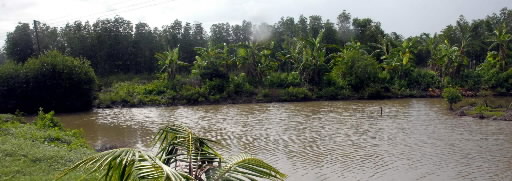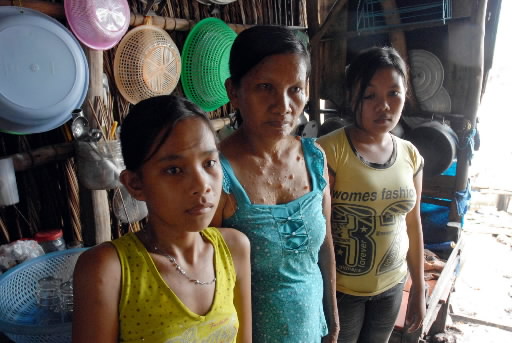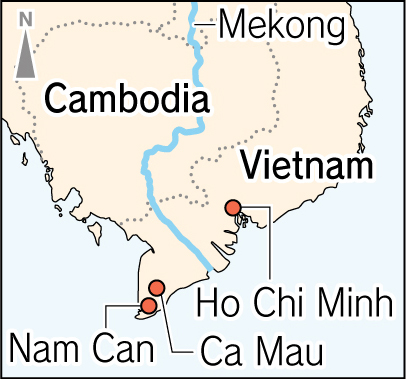Vietnam: 50 years after the use of defoliants, Part 1: Walking the affected areas, Article 4
Jul. 9, 2012
Article 4: Memories of mangrove trees
Foliage returns to “desert” resulting from deadly poison
by Takamasa Kyoren, Staff Writer
Health hazards via food chain
In Ca Mau, the southernmost province in Vietnam, I rode along a national highway toward Nam Can, its southernmost town. The area is a wetland with an elevation of no more than 1 meter above sea level. Boats filled with coconuts traveled a canal that flows through the area. Beyond were mangrove trees as far as the eye could see.
“Killing off this entire forest – America, or I should say people contemplate terrible things,” said Le Xuan Thai, 62, vice president of the Nam Can Association for Victims of Agent Orange/Dioxin with evident disgust.
During the war Ca Mau was a base for the National Front for the Liberation of South Vietnam (Viet Cong), and the U.S. military sprayed 2.5 million liters of defoliant on the area. As a result, almost half of the area’s mangrove forests, approximately 82,000 hectares, were killed off, and the coastline eroded. The number of birds and fish also drastically declined.
News photographer Goro Nakamura, 71, a resident of Saitama, has pursued the problem of defoliants over the years. He photographed the devastation in this area in 1976, the year after the war ended. One of his photos featured boys standing at the site of a mangrove forest that had been killed off. “It was a world of death,” he said. When Mr. Nakamura returned to the area in 1982, it was like a desert.
Shrimp farming for the Japanese market
Thirty years have passed since then. As a result of a government forestation policy, it is difficult to see the effects of defoliants.
Mr. Le and I set off by boat from the dock in Nam Can and headed for a shrimp farm. “You’re Japanese, so you must like shrimp,” he said. The brown, murky river was about 500 meters wide and resembled a sea of mud.
We landed next to a thatched house on the riverbank. Beside the house was a shrimp farming pond about 100 meters long. Mr. Le said the area had originally been thick with mangrove trees. “I don’t know about this area, but with the boom in shrimp farming many areas were illegally logged and then ponds were built,” he said. “Most of the shrimp is for the Japanese market.”
The forests, mangrove trees and arable land lost as a result of the spraying of defoliants amounted to a total of 2.2 million hectares, more than one tenth of the total area of the former South Vietnam. This is said to be the worst environmental devastation in history. Just after the end of the war, the Vietnamese government began planting trees in many areas, but the forests were not properly administered, and starting in the late 1980s there was widespread illegal logging to build shrimp farming ponds and to obtain raw material for pulp.
After that, the government turned the planting and forest administration over to local residents. A permit system for logging was created, and 70 to 80 percent of the mangrove forests recovered.
Concern about accumulation in the body
What happened to the highly toxic dioxin in the defoliants? No accurate surveys were ever done. “I don’t think it would be detected in the soil or seawater now,” said Mr. Le. He is of the opinion that the dioxin, which is not very soluble in water, mixed with the soil and was washed out to sea with squalls every year.
“If we had measured the amount of dioxin in the seawater and small fish back then, it would have been quite high,” Mr. Le said. Unlike Japan and other countries that have strict safety regulations, it is believed that some of the dioxin that got into the food chain has accumulated in the bodies of local residents.
Nguyen Thi Sa, 48, who lives in Ca Mau, has seven children. Five of them suffer from bone deformities or paralysis. After the war Ms. Nguyen developed many bumps resembling blisters on her body. They are painful to the touch, and she cannot sleep soundly.
The family’s house along a riverbank offers a glimpse into their difficult circumstances. Several months ago Ms. Nguyen’s 63-year-old husband left the village with two of their sons to look for work. “I ate fish caught locally every day,” she said. “I suppose it was my fault.” In contrast to the forests, which have recovered, the suffering of the people is great.
(Originally published on June 22, 2012)










